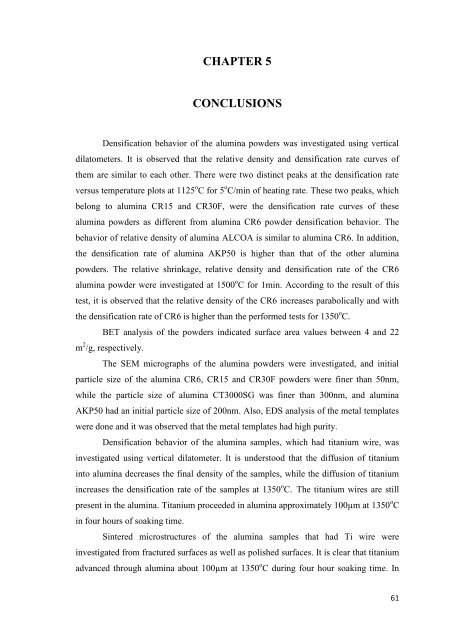use of metal templates for microcavity formation in alumina
use of metal templates for microcavity formation in alumina
use of metal templates for microcavity formation in alumina
You also want an ePaper? Increase the reach of your titles
YUMPU automatically turns print PDFs into web optimized ePapers that Google loves.
CHAPTER 5<br />
CONCLUSIONS<br />
Densification behavior <strong>of</strong> the alum<strong>in</strong>a powders was <strong>in</strong>vestigated us<strong>in</strong>g vertical<br />
dilatometers. It is observed that the relative density and densification rate curves <strong>of</strong><br />
them are similar to each other. There were two dist<strong>in</strong>ct peaks at the densification rate<br />
versus temperature plots at 1125 o C <strong>for</strong> 5 o C/m<strong>in</strong> <strong>of</strong> heat<strong>in</strong>g rate. These two peaks, which<br />
belong to alum<strong>in</strong>a CR15 and CR30F, were the densification rate curves <strong>of</strong> these<br />
alum<strong>in</strong>a powders as different from alum<strong>in</strong>a CR6 powder densification behavior. The<br />
behavior <strong>of</strong> relative density <strong>of</strong> alum<strong>in</strong>a ALCOA is similar to alum<strong>in</strong>a CR6. In addition,<br />
the densification rate <strong>of</strong> alum<strong>in</strong>a AKP50 is higher than that <strong>of</strong> the other alum<strong>in</strong>a<br />
powders. The relative shr<strong>in</strong>kage, relative density and densification rate <strong>of</strong> the CR6<br />
alum<strong>in</strong>a powder were <strong>in</strong>vestigated at 1500 o C <strong>for</strong> 1m<strong>in</strong>. Accord<strong>in</strong>g to the result <strong>of</strong> this<br />
test, it is observed that the relative density <strong>of</strong> the CR6 <strong>in</strong>creases parabolically and with<br />
the densification rate <strong>of</strong> CR6 is higher than the per<strong>for</strong>med tests <strong>for</strong> 1350 o C.<br />
BET analysis <strong>of</strong> the powders <strong>in</strong>dicated surface area values between 4 and 22<br />
m 2 /g, respectively.<br />
The SEM micrographs <strong>of</strong> the alum<strong>in</strong>a powders were <strong>in</strong>vestigated, and <strong>in</strong>itial<br />
particle size <strong>of</strong> the alum<strong>in</strong>a CR6, CR15 and CR30F powders were f<strong>in</strong>er than 50nm,<br />
while the particle size <strong>of</strong> alum<strong>in</strong>a CT3000SG was f<strong>in</strong>er than 300nm, and alum<strong>in</strong>a<br />
AKP50 had an <strong>in</strong>itial particle size <strong>of</strong> 200nm. Also, EDS analysis <strong>of</strong> the <strong>metal</strong> <strong>templates</strong><br />
were done and it was observed that the <strong>metal</strong> <strong>templates</strong> had high purity.<br />
Densification behavior <strong>of</strong> the alum<strong>in</strong>a samples, which had titanium wire, was<br />
<strong>in</strong>vestigated us<strong>in</strong>g vertical dilatometer. It is understood that the diffusion <strong>of</strong> titanium<br />
<strong>in</strong>to alum<strong>in</strong>a decreases the f<strong>in</strong>al density <strong>of</strong> the samples, while the diffusion <strong>of</strong> titanium<br />
<strong>in</strong>creases the densification rate <strong>of</strong> the samples at 1350 o C. The titanium wires are still<br />
present <strong>in</strong> the alum<strong>in</strong>a. Titanium proceeded <strong>in</strong> alum<strong>in</strong>a approximately 100µm at 1350 o C<br />
<strong>in</strong> four hours <strong>of</strong> soak<strong>in</strong>g time.<br />
S<strong>in</strong>tered microstructures <strong>of</strong> the alum<strong>in</strong>a samples that had Ti wire were<br />
<strong>in</strong>vestigated from fractured surfaces as well as polished surfaces. It is clear that titanium<br />
advanced through alum<strong>in</strong>a about 100µm at 1350 o C dur<strong>in</strong>g four hour soak<strong>in</strong>g time. In<br />
61

















